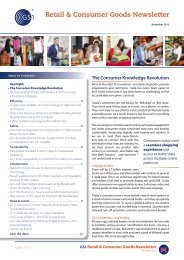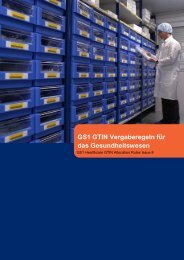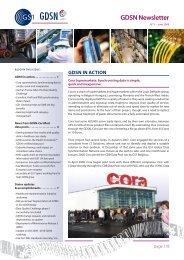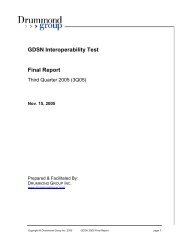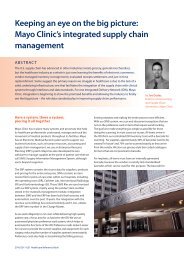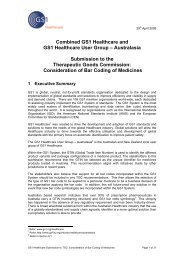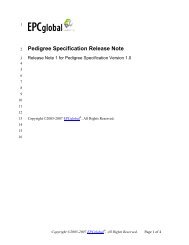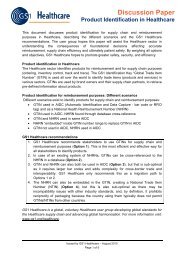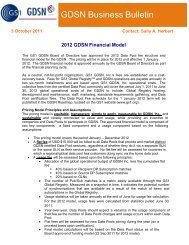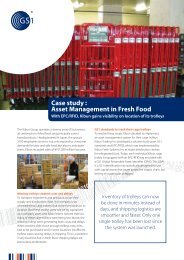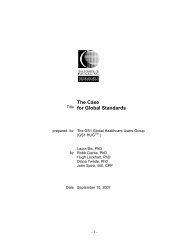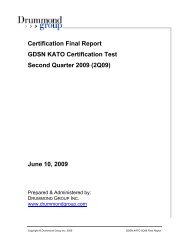Annual Report 2009-2010 - GS1
Annual Report 2009-2010 - GS1
Annual Report 2009-2010 - GS1
You also want an ePaper? Increase the reach of your titles
YUMPU automatically turns print PDFs into web optimized ePapers that Google loves.
<strong>GS1</strong> Argentina<br />
<strong>Annual</strong> study shows primary causes of empty shelves<br />
Out-of-stocks continue to be an issue<br />
Every year, <strong>GS1</strong> Argentina carries out a study to measure<br />
the average percentage and the causes of out-of-stock<br />
situations in supermarkets around the country. In <strong>2009</strong>,<br />
the eighth annual edition of this Out-of-Stock Study<br />
surveyed 462,152 food, beverage, personal care and<br />
household care items identified by their <strong>GS1</strong> GTIN (Global<br />
Trade Item Number). The survey registered an overall<br />
out-of-stock level of 14.6%, compared to 13.8% the year<br />
before, a year-on-year increase of around 8%.<br />
The study gathered data from 12 supermarket chains with<br />
198 stores in the federal capital area and the provinces of<br />
Buenos Aires, Neuquén, Córdoba, General Roca, Mendoza,<br />
Rosario, Bahía Blanca and Tucumán. Out-of-stock results<br />
ranged from a high of 17.1% in Córdoba Province to a low<br />
of 12.8% in Tucumán Province.<br />
The study also included data provided by 14<br />
manufacturers who were asked to confirm the data or to<br />
explain the circumstances that caused the out-of-stock<br />
situations. The survey found that out-of-stock levels by<br />
product category ranged from 14.9% for food, 13.1%<br />
for beverages, 17% for household items, and 14.4% for<br />
personal care products.<br />
Causes clearly identified<br />
The eight consecutive annual studies consistently show<br />
that three-quarters of all out-of-stock situations are<br />
caused by lack of replenishment by the merchandiser,<br />
despite the product being in stock at the back of the<br />
store; differences between the stock information in the<br />
logistics system and the actual stock in the store; and<br />
supplier delivery delays.<br />
This latest survey indicated that the responsibility for<br />
the out-of-stock situation rests with the retailer in 72.3%<br />
percent of cases; with suppliers in 16.7% of cases, with the<br />
distribution and replenishment centre in 10.7% of cases,<br />
and with the purchasing office in 0.3% of cases.<br />
The results clearly show that out-of-stock products at the<br />
shelf level affect everyone involved in the supply chain<br />
– suppliers, manufacturers, transporters, wholesalers and<br />
retailers. The study shows conclusively that the reduction<br />
“The study shows conclusively<br />
that the reduction of<br />
out-of-stock situations is the<br />
shared responsibility of the<br />
entire supply chain.”<br />
of out-of-stock situations is the shared responsibility of<br />
the entire supply chain. All the players along the supply<br />
chain must cooperate to reduce out-of-stocks, not only in<br />
order to optimise financial results, but most importantly,<br />
to improve customer satisfaction.<br />
Collaborative efforts help<br />
To help its member companies reduce out-of-stocks,<br />
<strong>GS1</strong> Argentina has coordinated a number of collaborative<br />
efforts between retailers and suppliers. In <strong>2010</strong>, Disco<br />
Supermarkets and a group of 10 suppliers that include<br />
Nestlé, Unilever, Kraft, P&G, Danone and other key local<br />
players are working with <strong>GS1</strong> Argentina on a process<br />
revision designed to improve the on-shelf availability of<br />
their largest selling SKUs.<br />
For more information about <strong>GS1</strong> Argentina, visit<br />
www.gs1.org.ar<br />
<strong>GS1</strong> MOs in Action<br />
41



